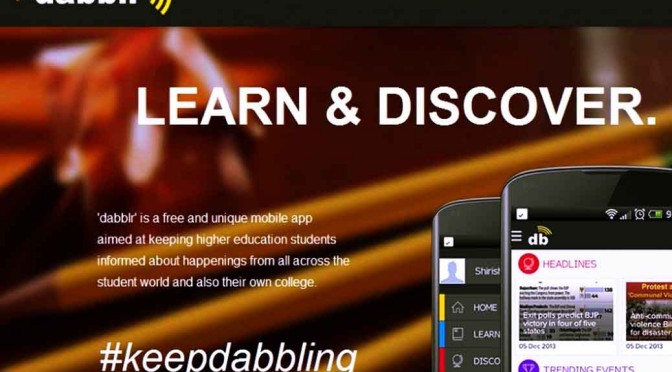Experiences
Experiences are precious, and learning from the experiences of others is, I think, a very efficient way of avoiding mistakes and identifying the patterns to success. I treasure them. I view it like, collecting XP (experience points) in a Pokémon game – where the game is your life and the greater XP you manage to collect, the better you do in the game.
A great man’s biography no doubt is one good source of this precious experience. A better way to go about collecting XP is by simply asking the successful person himself – by doing an interview maybe. That is what I did… (an interview once again!)
Red Matter Tech and Dabblr
I had a chat with one of the four masterminds, Srikant Rajasekharuni of, Red Matter Tech. They are the ones who chose themselves (not the traditional office cubicles) and brought in this one of its kind student companion smartphone app, Dabblr. It is creating waves in the student community. If you are a student and you have a smartphone that does not have Dabblr installed in it, you are seriously missing out on something.
It is an app which lets you carry the updates on most important college events, current affairs, open courseware, student deals, campus news, your time-table, and more, in your pocket all the time. The interface is slick and the app is neatly polished. You’ll get addicted.
[Get it here]
The Chat
Listen to what Srikant shares with us. Pay attention because “Learn and Discover” is what we do at AweSci too.
Me: Tell us about the company.
SR: We are Red Matter Tech, a relatively young product development and marketing firm started by four friends! It’s been almost 9 months all of us quit our jobs, we work out of our own office space and plugged in most of the time.
Me: Dabblr is your first product. It seems to be more than just an app. Can you tell us more about it?
SR: Dabblr prima facie, is a student companion app. If you are a student who’s looking for an application that will provide necessary information about your curricular, co & extra curricular life! Course and aptitude related gyaan. Aggregation of content from various news feeds and event information! You can even check out your college timetable on the application!
Me: Who is the team behind your first product – Dabblr?
SR: The team consists of us, the co-founders. Bhagat handles tech. Shirish product. Rohit handles operations and sales and I handle content and marketing. All of us have prior decent experience in marketing. Shirish and I studied together in MICA, Shirish & Rohit have studied from the same engineering college. 80 % of the current team have experience in the gaming industry too. Avani, Bhagat’s much better half is the coder!
Me: Why did you feel the need for this app?
SR: As we graduated from engineering and moved out of Hyderabad for further studies, we noticed a stark difference in approach towards life from students of different states. It made us realise that education is not the same across the country and we decided to create a platform of equal opportunities and information. And completely free.
Me: What is that one big lesson you learnt while developing your first product? Something which you’d have not learnt, had you not endeavored to create this.
SR: Biggest learning would be the unconditional support that your family and friends extend when you are completely focussed on creating something on your own.
Me: Where on the web and print have you been featured?
SR: We have been on Inc42, The Hindu and Deccan Chronicle so far. All of them have been real kind to us.
Me: People who inspire you, the books you love, websites and blogs you read and your favorite pastimes. Favorite music, specific songs.
SR: Inspirations: B R Ambedkar, Rajnikanth.
Books I Love: The Foundation Series, Sandman (Graphic Novels)
Websites: Reddit, of course. Business insider. Awesci.
Me: Before you go, share with us an interesting piece of science trivia for the day
SR: Total Eclipses are possible only because the sun and moon appear the same size from earth. That’s possible only because the sun’s diameter is about 400 times larger than that of the moon – Amazingly, if you think coincidences don’t happen, the sun is also about 400 times farther away. Mind blowing!
[Dabblr Website] [Facebook Page]






